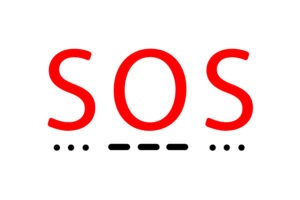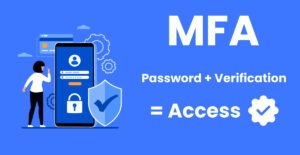
In the 1940s, grocery stores were much different than they are today. The checkout process was a manual, tedious task that relied on cashiers entering prices for every item sold. There were no automated systems to scan items and tally totals, which slowed the checkout process and left room for human error. But all of that changed thanks to an unlikely source of inspiration: the SOS distress signal.
The story of how an SOS led to the invention of barcodes is an intriguing tale of innovation, a beach, and a man with a passion for problem-solving. This story begins with Norman Joseph Woodland, who, along with his colleague Bernard Silver, was responsible for creating the concept of barcodes that we use in stores worldwide today.
The Problem: Automating Grocery Checkout
In 1948, a supermarket manager approached Bernard Silver, a graduate student at Drexel Institute of Technology, with a simple yet profound request: Could someone create a system to automate the checkout process? The manager wanted a way to quickly identify products and their prices without needing to manually enter them into the register. This system would make the checkout process faster, reduce human errors, and revolutionize the grocery industry.
Silver shared the idea with his friend Norman Woodland, and the two of them began brainstorming how they could achieve such a feat. Woodland, who had a background in engineering, took the idea to heart and began searching for inspiration.
At the time, the technology for such a system didn’t exist. Computers were in their infancy, and there were no sensors or scanners capable of reading product information. However, Woodland believed that a machine-readable code could be the key to solving the problem. What he needed was a way to encode the product information in a form that a machine could easily interpret.
Woodland’s Inspiration: The SOS Signal
Woodland’s breakthrough came from an unexpected source: his familiarity with Morse code. Woodland had been a Boy Scout, and like many scouts, he learned the fundamentals of sending distress signals using Morse code, especially the iconic SOS—a series of three dots, three dashes, and three dots (… — …).
In Morse code, each letter or number is represented by a unique combination of short and long signals, known as dots and dashes. These simple codes, which were used in everything from ship communications to emergency broadcasts, sparked an idea in Woodland’s mind. He began to wonder if a similar system of short and long signals—dots and dashes—could be used to encode information in a visual form that machines could read.
At the time, this idea was still abstract. Woodland wasn’t sure how to turn it into a tangible product, but he knew that Morse code’s simplicity could provide a blueprint. The challenge was translating that blueprint into something that could work in a grocery store.
A Key Moment: Drawing in the Sand
One of the most iconic moments in the story of barcodes happened on a beach in Florida. After spending countless hours thinking about how to solve the problem, Woodland decided to take a break and clear his mind. He traveled to the coast and spent some time walking along the beach, letting his thoughts drift. Yet, even as he enjoyed the sun and sand, the problem of automating grocery checkout still weighed on him.
Then, it happened—a eureka moment that would change the world.
As Woodland sat on the beach, he imagined himself stranded on a deserted island, desperately trying to signal a passing airplane. His mind, still fixated on Morse code, drifted to the idea of sending an SOS—a distress signal made up of dots and dashes—to get the attention of a rescuer. In his imagination, he began exaggerating the dots and dashes, turning the simple signal into something more prominent that could be seen from a distance.
Suddenly, inspiration struck. Woodland knelt down in the sand and began drawing thick, bold lines with his fingers. He started with dots and dashes like Morse code, but soon he extended the dashes, imagining them as lines of varying thickness. In that moment, he realized that he could encode information using a series of lines and spaces, just like Morse code encoded information with dots and dashes.
The beach scene was an embodiment of simplicity. Just as Morse code was an elegant solution to long-distance communication, Woodland’s lines in the sand represented a way to communicate product information to machines. This idea would eventually become the barcode—a series of vertical lines of different widths, representing data that a machine could read.
From Circles to Lines: Refining the Barcode
Woodland’s initial concept wasn’t a linear barcode like we see today. His first idea was actually a circular barcode, which he and Silver called the “bullseye” design. The reason for the circular shape was to ensure that scanners could read the code from any angle. Woodland envisioned a code that could be scanned in any direction, making it easier for cashiers to use.
The bullseye design worked in theory, but in practice, it proved difficult to implement. Scanners at the time were not advanced enough to reliably read the circular codes. Woodland and Silver needed to simplify the design further to make it work with the technology of the era.
The breakthrough came when they switched from a circular to a linear design. By arranging the code as a series of vertical lines of different thicknesses, Woodland and Silver created a system that was easier for machines to read. Each line represented a different piece of information, just as the dots and dashes in Morse code conveyed different letters and numbers.
This new design was much more efficient, and it laid the foundation for the modern barcode we see on products today.
The Patent and Evolution of Barcodes
In 1952, Woodland and Silver received a patent for their “Classifying Apparatus and Method,” which described their barcode system. The invention, however, did not immediately revolutionize the industry. The technology required to read the barcodes, such as lasers and optical scanners, was still in development. It would take another two decades before barcode scanning technology caught up with Woodland and Silver’s vision.
In the 1970s, the adoption of barcodes began to accelerate, thanks to the development of the Universal Product Code (UPC) system, which used a version of Woodland and Silver’s barcode design. By the mid-1970s, supermarkets were using barcode scanners to quickly and efficiently check out customers. This system dramatically improved the speed and accuracy of the checkout process, fulfilling the original request that had inspired Silver and Woodland back in 1948.
Barcodes Today: A Global Impact
The barcode system that started with an SOS signal and a few lines in the sand has grown into one of the most widely used technologies in the world. Barcodes are now essential in retail, logistics, healthcare, and many other industries. They enable businesses to track products, manage inventory, and streamline operations.
Today, more than 6 billion barcodes are scanned every day worldwide, and the technology continues to evolve. New forms of machine-readable codes, such as QR codes, have emerged, but the principles behind them remain the same as those that Woodland discovered on that Florida beach.
Conclusion: The Power of Simple Ideas
The invention of barcodes is a reminder that some of the most transformative ideas come from simple sources of inspiration. Woodland’s knowledge of Morse code and his imaginative moment on a beach were the sparks that led to the creation of a technology that revolutionized entire industries.
From the simplicity of dots and dashes to the practicality of lines and spaces, barcodes are a testament to the power of creative thinking. What started as a desire to automate the grocery checkout process became a global innovation—one that continues to shape the way we interact with products and technology today.
Next time you scan a barcode at the grocery store, take a moment to remember the story of Norman Woodland and how an SOS on a deserted island led to the invention of a system that changed the world.
For an assessment of your business network, Please contact us!


